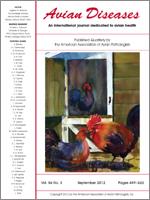Nucleotide and predicted amino acid sequences of the infectious bursal disease virus (IBDV) surface protein VP2 have been used to identify strains of the virus and place them into phylogenetic groups. The amino acids across the hypervariable sequence region of VP2 (hvVP2) vary, but typically variant viruses have amino acids 222T, 249K, 286I, and 318D and classic viruses have 222P, 249Q, 286T, and 318G. A molecular epidemiologic study was conducted from 2001 to 2011 in commercial chickens (Gallus gallus) from Mexico, Colombia, and Venezuela. Although many IBDVs were identified, most had the typical variant or classic amino acid sequences across the hvVP2 region. Four viruses identified in 2004, one in 2006, and 10 in 2011 from Mexico had the amino acids 222T, 249Q, 286T, and 318D. Six samples from Venezuela in 2001, one sample from Colombia in 2001, two samples from Venezuela in 2004, and one sample from Venezuela in 2005 had the amino acids 222P, 249K, 286I, and 318G. These combinations of classic and variant amino acid sequence markers had not been identified previously in any IBDV strains. The VP2 amino acid sequences in the PBC and PHI loop structures of the Venezuela and Colombia viruses were similar to most classic viruses, whereas their minor PDE and PFG loop sequences were typical of Delaware variant strains. The Mexico viruses had VP2 PBC loop sequences that were typical of variant IBDV strains, but their minor PDE and PFG loop structures contained amino acids that were similar but not identical to classic strains. The PHI loop sequences of the Mexico viruses had 318D that is typical of a Delaware variant virus, but the other amino acids in this loop structure distinguished them from all other IBDV strains. The data suggest that one or more recombination events may have occurred to create this type of sequence diversity. Because of importation regulations, immunologic studies could not be conducted in the United States to determine the antigenicity of the viruses examined in this study. The amino acid sequence data, however, suggest they would contain antigenic epitopes of both variant and classic IBDVs.
How to translate text using browser tools
1 September 2012
Molecular Epidemiologic Evidence of Homologous Recombination in Infectious Bursal Disease Viruses
Daral J. Jackwood
ACCESS THE FULL ARTICLE

Avian Diseases
Vol. 56 • No. 3
September 2012
Vol. 56 • No. 3
September 2012




